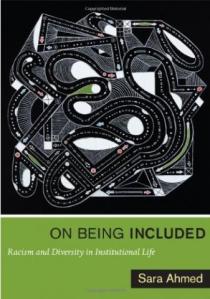by Sara Ahmed
It has been heartening to witness a heightened concern with race and higher education. An increase of concern helps to expose the lack of previous concern. But is it a welcome exposure. We have had articles in the mainstream media reflecting on the extraordinarily low numbers of black (especially black female) professors in the UK as well as events such as “Why isn’t my professor black?” in which black voices have spoken about the relative absence of black voices. A network for Black British Academics was set up in 2013. One college has introduced Black Studies.
Activity can generate debate. For example, Dhanveer Singh Brar has recently suggested the question “Why isn’t my professor black?” needs to be accompanied by other questions, ones we might pose back to universities. If people of colour are included in the institutions of whiteness, are those institutions necessarily transformed? And are we at risk, to use Brar’s terms, of creating a
“class of experts” to “administer the race problem”?
One of the aims of Media Diversified is to address the ubiquity of whiteness. Ubiquity is a strong word. It is the right word. Ubiquity suggests omnipresent; everywhere. Over the course of my 20 years as an academic, I have experienced whiteness everywhere; the ubiquity of whiteness. There have been a few moments, rare and special moments which I recall as exception, when I have looked out and not encountered “a sea of whiteness.” Some of my favourite events thus far have been when I have been part of a “sea of brownness” either at inaugural lectures for women of colour (I think especially of Avtar Brah and Heidi Safia Mirza’s inaugurals – both have mentored and inspired my generation of Black feminism) or at events that have been set up to address race. “To address race”: unless race is taken up as an explicit object of concern, made into a question, whiteness is the default position.

In 2012 I published a book On Being Included: Racism and Diversity in Institutional Life, which drew on some of my experiences as an academic of colour living with and in the ubiquity of whiteness (or what we can also call simply “institutional whiteness”). Reflecting back on the process, I had a hard time getting this book published. Two publishers who first expressed interest eventually declined: one expressing doubts about whether there was a big enough market for such a book with such concerns; the other expressing doubts about the content (the material was described by one editor as “too subjective”). The book does draw on my own involvement in the world I am describing (I called it simply “the diversity world”), including observations of diversity and equality committees, meetings, and conferences that I attended over a ten year period. It also drew on 21 interviews with diversity practitioners that I conducted myself, as well as some data drawn from other projects in our research team (the team involved multiple projects on diversity and leadership across Adult and Community Learning, Further Education as well as Higher Education).
What does it mean for this material then to have been described as “too subjective”? Speaking about whiteness as someone who is not white often means being heard as speaking about yourself. I think “subjectivity” becomes a problem because some of us are reduced to subjectivity, as having an experience that is particular to ourselves. Some subjects can disappear or speak for the universal: to have a view from nowhere means you can speak of everywhere. When “the others” speak, our view is from somewhere, we speak about somewhere. Many of us who are black or minority ethnic have probably experienced the very requirement to tell our own story, to explain where we are coming from (for further discussion, see my blog post, “Being in Question”). Indeed that we come to embody diversity (to add colour to whiteness), or how we come to be “the race person” is part of the problem: whiteness ends up being neutralised; the default position.
The difficulty of getting this book published, I would suggest, was about encountering a wall, the wall of whiteness.[i] What do I mean by the wall of whiteness? The idea of walls came up repeatedly in my interviews with diversity practitioners, those appointed to institutionalise commitments to diversity. Most of the interviews took place just after the Amendment to the Race Relations Act of 2000, which required that all public institutions have race equality policies. Some of the people I interviewed were appointed to write those policies. The appointment of a diversity officer seems to express a commitment to diversity. But when an appointment is a form of compliance, it often falls short of a commitment. I learned so much from listening to those who wrote race equality documents. One officer described diversity work as a “banging your head against a brick wall job.” You encounter these walls, what blocks transformation, in the very organisations that gave you the task of transforming them.
I learned as well from doing these interviews and from my own experience of being on race equality and diversity committees how the very technologies introduced to transform institutional inequalities can themselves become walls. One practitioner said that policies can be used to create the impression that “We’ve done race, when we clearly haven’t done race.” I have myself encountered how policy documents can be used to conceal what they were intended to challenge: the VC at a university I worked said “We are good at race equality” when we were judged as having a “good policy.”
The very appearance of doing something can be a way of not doing something. There was one very striking example from my interviews of how a diversity policy had been introduced, with considerable effort (and resistance), but nothing changed in practice; nothing happened although on paper it appeared things had. A wall is what tends to keep its place. Unless you come up against this wall, though, the university appears as committed to diversity: as happy as the documents that circulate. Indeed it was listening to practitioners talk about how happy stories of diversity can lead to the concealment of inequalities and racism that led me to ask questions of what happiness is doing. Happiness seems to be about creating a shiny surface. One practitioner called diversity a shiny apple that underneath has a rotten core.

Take this example: one human resources department at an elite university sponsored a research project to find out how external communities perceived their organisation. The research found that the university was perceived as white. Their response to the finding was to change their prospectus to include more bodies of colour. You know the kinds of images of happy colourful faces that are instantly recognisable as images of diversity. Diversity here translates into changing the whiteness of the image rather than changing the whiteness of the organisation. Indeed the whiteness of the organization can be supported, even reproduced, by generating new more diverse or colourful images. Nirmal Puwar describes in her important book Space Invaders: Race, Gender, and Bodies out of Place (2004) how diversity can then end up being about including people who “look different.” That inclusion can be imagined, as well as real.
In such inclusions are new exclusions. For example, when race equality is reframed in positive terms (as a positive duty), more negative terms can end up being the terms you are not supposed to use. When diversity is put into circulation, other terms are put out. And this is what we found in our study: that the focus on positive terms, toolkits, solutions became another way of concealing the problem of racism, a way of not even saying that word. The final report for our diversity project was never published: and one of the reasons for this was because it was judged as too focused on racism. We ourselves were supposed to return their commitment (this “their” refers to those who funded the project) by telling happy stories of diversity. Even using the word “racism” meant being heard as ungrateful. We became for the funders a sore point.
Whiteness can be understood as a wall in the sense that it keeps its place: even the attempts to modify whiteness can end up supporting it. Whiteness is like a shape that “bounces back” as soon as the pressure to modify it is eased. The experience of anti-racist work often feels like this: banging your head against a brick wall. If the wall keeps it place, it is you that gets sore. You come up against the same thing, over and over again.
There is no doubt that such repeated encounters are oppressive and diminishing. Black feminists such as Audre Lorde have taught me this: that describing what we come up against is itself a political action. Walls are often reproduced through not being perceived to exist (if we perceive them it is assumed our perception is the problem). It is one of the ways walls keep their place though not the only way. We need to describe the tangibility of whiteness: to make whiteness thick by thickening our own descriptions of whiteness. Of course we will encounter resistance. And that is why anti-racism can only ever be lived as a collective project; we have to support each other often by sharing with each other “wall stories.” There can be relief in knowing that we come up against is shared. And with relief, we can keep going.
[i] In the end, the book was published by a US based publisher. I did eventually get an offer from a UK based commercial publisher, but it came too late in the process.
Sara Ahmed is an Australian and British academic working at the intersection of feminist theory, queer theory, critical race theory and post colonialism. Sara is a Professor in Race and Cultural Studies. Born in Salford, England to a Pakistani father and English mother. She has published 6 single-authored books: Differences that Matter: Feminist Theory and Postmodernism (1998); Strange Encounters: Embodied Others in Post-Coloniality (2000); The Cultural Politics of Emotion (2004); Queer Phenomenology: Orientations, Objects, Others (2006); The Promise of Happiness (2010), which was awarded the FWSA book prize in 2011 for “ingenuity and scholarship in the fields of feminism, gender or women’s studies”; and On Being Included: Racism and Diversity in Institutional Life (2012). Buy books
This article was commissioned for our academic experimental space for long form writing curated and edited by Yasmin Gunaratnam. A space for provocative and engaging writing from any academic discipline.
As well as responding to current concerns and events, it’s a space for writing that endures, for cutting-edge ideas and approaches that fortify and inspire. The articles you will find in this space will show clarity without jargon, careful thinking that takes risks, runs off with ideas but doesn’t compromise on rigour.

This is a real problem. In 2000 I and a few others set up a temporary group of PhD and PG students under the name Black Cultural Studies Group (it stopped functioning around 2003). The idea was that research students who studied “Black” topics lacked a supportive infrastructure. Most lecturers were also of one predictable background. Whilst I was personally lucky to have been taught by Paul Gilroy and attended lectures by Lola Young and Stuart Hall at the time, many were not that lucky. I think it is essential that universities and the media are as diverse as human society. I am disheartened to hear this is still an issue for students today!
LikeLike